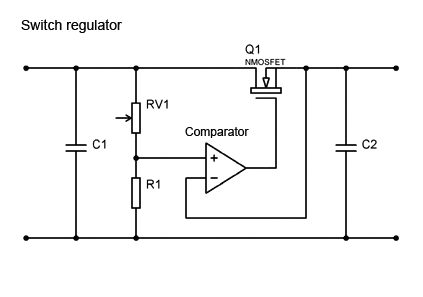Extremely simple pulse width modulation regulator
This circuit is very simple and has been used both on a at 70W halogen lamp and a LED and worked fine without any problems. For the lamp a power FET was used and for the LED a ULN2003 darlington transistor was used. The comparator simply compares the output voltage with a reference voltage. When the output voltage exceeds the reference voltage, the transistor gets turned off. Since the transistor is either turned fully on or fully off most of the time there is little heating of the transistor.
If you have problems understanding how it works then think infinite gain. This is achieved in a simple way by using a comparator like LM393/LM339. If you are using an operational amplifier then you need to take some care to avoid linear operation.
This circuit has never caused any problems, but it may or may not emit electric noise and/or turn out to be unstable under certain conditions.
Under high loads it will start to act like a PWM regulator and will only be suitable for loads that only cares about the average power.
